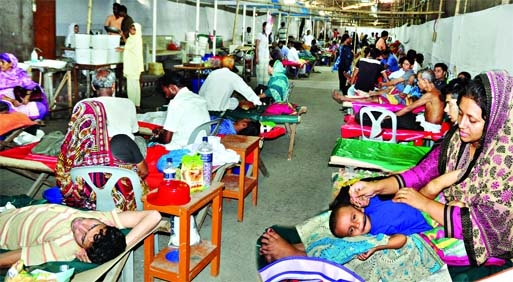
On an average 700 patients, mostly from slum areas in the city affected with diarrhoeal diseases are being admitted to International Centre for Diarrhoeal Diseases Research, Bangladesh (ICDDR,B) everyday, Azhar Uddin, Chief Physician of the hospital said.This increasing number is mainly due to severe hit wave that sweeping across the country, he said, adding, “The number of patients may increase if the heat wave prolongs for more days”. Patients and their guardians told this correspondent that the shortage of pure drinking water was one of the main reasons of the disease. The shortage of gas supply and load shedding also contributes to water shortage, they said. “We have to drink contaminated tape water as we can’t boil it due to shortage of gas supply,” one of the patients Abdul Quader said. Today’s highest temperature 40.7 degrees Celsius was recorded at Rangamati and the lowest 18.6 degrees Celsius at Srimangal, says Metrological Department.Severe heat wave is sweeping over the regions of Sitakunda, Rangamati, Jessore, Kushtia and Khepupara, said the Met office.A total of 421 diarrhoea patients were admitted to ICDDR,B till 3:00pm on Tuesday, Media Manager of the hospital said. Some doctors of the ICDDR,B echoing with the patients and their guardians said that the poor access to safe drinking water and higher temperature have resulted in an upsurge in diarrhoea.People are forced to drink from contaminated sources and this is the major cause for the increasing number of patients, they added. According to the ICDDR,B, 6,697 patients were admitted in the last nine days which was 50 per cent more in the same period of the previous year.People in the areas of Mohammadpur, Mirpur, Moghbazar, Central Road and Noyatola have been facing severe water crisis over the couple of days.Dhaka WASA (Dhaka Water Supply and Sewerage Authority) officials said the situation has come to this stage due to some technical problems coupled with the fall in ground water level.Dhaka WASA Managing Director Taqsem A Khan said, “There are 670 pumps, but 12 to 15 of them became non-functional due to technical problems. For this reason, people in many areas are gripped by shortage of water.””Within a few days we will be able to resolve the technical problem, but if the water level drops further then we will be able to pump less amount of water,” he added.The water demand of Dhaka and its adjacent areas is 220 litres per day. It reaches 230 litres a day at times. The ‘production’ capacity of water on the part of Dhaka WASA is 242 litres per day, but it can pump around 230 litres a day.Dhaka WASA MD said ten vigilance teams were monitoring the pumping of water. “We are providing plastic water tanks to some areas, where people are facing crisis of water,” he added. He expressed the hope that this situation would be under control when rain started.The Power Development Board (PDB) recorded 113 megawatt (MW) of load-shedding on April 17 across the country. It increased to 375 MW on April 19 and came down to 269 MW on April 20.However, no load-shedding was reported on April 18 (Friday) as the demand of electricity was low at the weekend.On April 20, while Chittagong experienced 72 MW load-shedding, Khulna faced 80 MW load-shedding, Rajshahi 75 MW, Comilla 54 MW, Mymensingh 40 MW, Barisal 13 MW and Rangpur 41 MW, while the total load-shedding was 375 MW. The PDB said there was no load-shedding in Dhaka and Sylhet on April 20.

